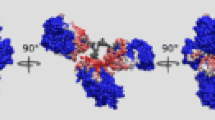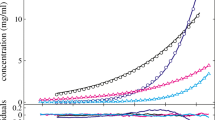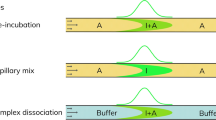Abstract
Protein-protein interactions in monoclonal antibody solutions are important for the stability of a therapeutic drug and directly influence viscosity in concentrated protein solutions. This study describes the use of small-angle scattering to estimate protein-protein interactions at high concentrations of the IgG1 NISTmAb reference material and validate colloidal models for interacting molecules. In particular, we studied the colloidal stability of the NISTmAb at high protein concentrations and analyzed protein-protein interactions upon adding sodium chloride and its effect on viscosity. Isotropic colloidal models for interacting molecules were combined with an ensemble of atomistic structures from molecular simulation to account for the flexibility of the NISTmAb in solution. In histidine formulation buffer, net repulsive electrostatic interactions are important for the colloidal stability of the NISTmAb at high concentrations. Addition of sodium chloride increased the viscosity of the NISTmAb and decreased the colloidal stability due to charge screening of the repulsive interactions. The interactions at high concentrations (up to ~ 250 mg/mL) were consistent with those from light scattering at low concentrations (below ~ 20 mg/mL). However, in the presence of sodium chloride, the screening of charges was less pronounced with increasing protein concentration and the interactions approached those of the repulsive hard-sphere models. Additionally, we studied the NISTmAb under frozen conditions using in situ neutron scattering to analyze the crowded state as proteins are excluded from the water-rich phase. In the frozen samples, where protein concentration can reach hundreds of mg/mL in the protein-rich phase, sodium chloride did not affect the molecular spacing and crowding of the NISTmAb.

Net repulsive interactions in concentrated NISTmAb solutions assessed by small-angle neutronscattering.







Similar content being viewed by others
Notes
Certain commercial equipment, instruments, materials, suppliers, or software are identified in this paper to foster understanding. Such identification does not imply recommendation or endorsement by the National Institute of Standards and Technology, nor does it imply that the materials or equipment identified are necessarily the best available for the purpose.
References
Agrawal NJ, Helk B, Kumar S, Mody N, Sathish HA, Samra HS, et al. Computational tool for the early screening of monoclonal antibodies for their viscosities. MAbs. 2016;8(1):43–8.
Apfel U, Grunder R, Ballauff M. A turbidity study of particle interaction in latex suspensions. Colloid Polym Sci. 1994;272(7):820–9.
Blanco MA, Sahin E, Li Y, Roberts CJ. Reexamining protein-protein and protein-solvent interactions from kirkwood-buff analysis of light scattering in multicomponent solutions. J Chem Phys. 2011;134(22):225–103.
Blanco MA, Perevozchikova T, Martorana V, Manno M, Roberts CJ. Protein-protein interactions in dilute to concentrated solutions: a-chymotrypsinogen in acidic conditions. J Phys Chem B. 2014;118(22):5817–31.
Brookes EH, Anjum N, Curtis JE, Marru S, Singh R, Pierce M. Genapp module execution and airavata integration. In: 2014 9th gateway computing environments workshop, pp. 9–12 2014.
Carpenter JF, Randolph TW, Jiskoot W, Crommelin DJA, Middaugh CR, Winter G, et al. Overlooking subvisible particles in therapeutic protein products: gaps that may compromise product quality. J Pharm Sci. 2009;98(4):1201–5.
Carrasco B, de la Torre JG, Davis KG, Jones S, Athwal D, Walters C, et al. Crystallohydrodynamics for solving the hydration problem for multi-domain proteins: open physiological conformations for human igg. Biophys Chem. 2001;93(2–3):181–96.
Castellanos MM, Mattison K, Krueger S, Curtis JE. Characterization of the NISTmAb Reference Material using small-angle scattering and molecular simulation. Part I: Dilute solution structures. Anal Bioanal Chem. 2018. https://doi.org/10.1007/s00216-018-0868-2.
Castellanos MM, Pathak JA, Leach W, Bishop SM, Colby RH. Explaining the non-newtonian character of aggregating monoclonal antibody solutions using small-angle neutron scattering. Biophys J. 2014;107(2):469–76.
Castellanos MM, Clark NJ, Watson MC, Krueger S, McAuley A, Curtis JE. Role of molecular flexibility and colloidal descriptions of proteins in crowded environments from small-angle scattering. J Phys Chem B. 2016;120(49):12,511–8.
Castellanos MM, McAuley A, Curtis JE. Investigating structure and dynamics of proteins in amorphous phases using neutron scattering. Comput Struct Biotechnol J. 2016;15:117–30.
Chen SH, Bendedouch D. Structure and interactions of proteins in solution studied by small-angle neutron scattering. In: Enzyme structure part K. Methods in enzymology vol 130, pp. 79–116. Academic Press 1986. https://doi.org/10.1016/0076-6879(86)30009-0
Chen SH, Broccio M, Liu Y, Fratini E, Baglioni P. The two-yukawa model and its applications: the cases of charged proteins and copolymer micellar solutions. J Appl Crystallogr. 2007;40:S321–6.
Curtis JE, McAuley A, Nanda H, Krueger S. Protein structure and interactions in the solid state studied by small-angle neutron scattering. Faraday Discuss. 2012;158:285–99.
Curtis JE, Nanda H, Khodadadi S, Cicerone M, Lee HJ, McAuley A, et al. Small-angle neutron scattering study of protein crowding in liquid and solid phases: lysozyme in aqueous solution, frozen solution, and carbohydrate powders. J Phys Chem B. 2012;116(32):9653–67.
Curtis JE, Raghunandan S, Nanda H, Krueger S. Sassie: a program to study intrinsically disordered biological molecules and macromolecular ensembles using experimental scattering restraints. Comput Phys Commun. 2012;183(2):382–9.
Godfrin PD, Zarraga IE, Zarzar J, Porcar L, Falus P, Wagner NJ, et al. Effect of hierarchical cluster formation on the viscosity of concentrated monoclonal antibody formulations studied by neutron scattering. J Phys Chem B. 2016;120(2):278–91.
Gokarn Y, Agarwal S, Arthur K, Bepperling A, Day ES, Filoti D, et al. Biophysical techniques for characterizing the higher order structure and interactions of monoclonal antibodies, chap. 6, pp. 285–327. ACS Symposium Series. 2015.
Hammouda B. Probing nanoscale structures-the sans toolbox. Gaithersburg: Natl. Institute Standards Technology Center for Neutron Research 2016. https://www.ncnr.nist.gov/staff/hammouda/the_SANS_toolbox.pdf.
Hayter JB, Penfold J. An analytic structure factor for macroion solutions. Mol Phys. 1981;42(1):109–18.
Inouye H, Houde D, Temel DB, Makowski L. Utility of solution x-ray scattering for the development of antibody biopharmaceuticals. J Pharm Sci. 2016;105(11):3278–89.
Kline S. Reduction and analysis of sans and usans data using igor pro. J Appl Crystallogr. 2006;39(6):895–900.
Li L, Kumar S, Buck P, Burns C, Lavoie J, Singh S, et al. Concentration dependent viscosity of monoclonal antibody solutions: explaining experimental behavior in terms of molecular properties. Pharm Res. 2014;31(11):3161–78.
Liu Y, Chen WR, Chen SH. Cluster formation in two-yukawa fluids. J Chem Phys. 2005;122(4):044,507–13.
Mosbæk CR, Konarev PV, Svergun DI, Rischel C, Vestergaard B. High concentration formulation studies of an igg2 antibody using small angle x-ray scattering. Pharm Res. 2012;29(8):2225–35.
Perkins SJ, Wright DW, Zhang H, Brookes EH, Chen J, Irving TC, et al. Atomistic modelling of scattering data in the Collaborative Computational Project for Small Angle Scattering (CCP-SAS). J Appl Crystallogr. 2016;49(6):1861–75.
Roberts CJ. Therapeutic protein aggregation: mechanisms, design, and control. Trends Biotechnol. 2014;32(7):372–80.
Roberts CJ, Wang W. Aggregation of therapeutic proteins. 1edn ed. New York: Wiley; 2010.
Sarangapani PS, Weaver J, Parupudi A, Besong TMD, Adams GG, Harding SE, et al. Both reversible self-association and structural changes underpin molecular viscoelasticity of mab solutions. J Pharm Sci. 2016;105(12):3496–506.
Schiel JE, Davis DL, Borisov OV. State-of-the-art and emerging technologies for therapeutic monoclonal antibody characterization volume 1. monoclonal antibody therapeutics: Structure, function, and regulatory space. In: Schiel JE, Davis DL, Borisov OV, editors. State-of-the-art and emerging technologies for therapeutic monoclonal antibody characterization volume 1. Monoclonal antibody therapeutics: structure, function, and regulatory space, vol 1, pp. ix–xi. ACS Symposium Series. 2014.
Schiel JE, Davis DL, Borisov OV. State-of-the-art and emerging technologies for therapeutic monoclonal antibody characterization volume 2. biopharmaceutical characterization: the nistmab case study. In: Schiel JE, Davis DL, Borisov OV, editors. State-of-the-art and emerging technologies for therapeutic monoclonal antibody characterization volume 2. Biopharmaceutical characterization: the NISTmAb case study, pp. ix–xii. ACS Symposium Series. 2015.
Schiel JE, Davis DL, Borisov OV. State-of-the-art and emerging technologies for therapeutic monoclonal antibody characterization volume 3. defining the next generation of analytical and biophysical techniques. In: Schiel JE, Davis DL, Borisov OV, editors. State-of-the-art and emerging technologies for therapeutic monoclonal antibody characterization volume 3. Defining the next generation of analytical and biophysical techniques, pp. ix–x. ACS Symposium Series. 2015.
Schwegman JJ, Carpenter JF, Nail SL. Evidence of partial unfolding of proteins at the ice/freeze-concentrate interface by infrared microscopy. J Pharm Sci. 2009;98(9):3239–46.
Shire SJ, Shahrokh Z, Liu J. Challenges in the development of high protein concentration formulations. J Pharm Sci. 2004;93(6):1390–402.
Velev OD, Kaler EW, Lenhoff AM. Protein interactions in solution characterized by light and neutron scattering: comparison of lysozyme and chymotrypsinogen. Biophys J. 1998;75(6):2682–97.
Yearley EJ, Zarraga IE, Shire SJ, Scherer TM, Gokarn Y, Wagner NJ, et al. Small-angle neutron scattering characterization of monoclonal antibody conformations and interactions at high concentrations. Biophys J. 2013;105(3):720–31.
Yearley EJ, Godfrin PD, Perevozchikova T, Zhang H, Falus P, Porcar L, et al. Observation of small cluster formation in concentrated monoclonal antibody solutions and its implications to solution viscosity. Biophys J. 2014;106(8):1763–70.
Acknowledgements
The authors acknowledge the following scientists for their help and support to this work: Zhiyuan Wang (Tsinghua University) and Yun Liu (NIST, University of Delaware) for their help with SANS data collection, John Schiel (NIST, IBBR) for making the material available for this study and guiding the SEC measurements, Marco Blanco (NIST, IBBR) for discussions on G22, Samiul Amin (previously affiliated with Malvern Instruments) and Neil Lewis (Malvern Instruments) for starting and supporting a collaboration between Malvern and NIST. MMC acknowledges financial support from the NIST biomanufacturing initiative. This work used CCP-SAS software developed through a joint EPSRC (EP/K039121/1) and NSF (CHE-1265821) grant.
Author information
Authors and Affiliations
Corresponding author
Ethics declarations
Conflict of interest
All authors of this article declare no conflict of interest.
Rights and permissions
About this article
Cite this article
Castellanos, M.M., Mattison, K., Krueger, S. et al. Characterization of the NISTmAb Reference Material using small-angle scattering and molecular simulation. Anal Bioanal Chem 410, 2161–2171 (2018). https://doi.org/10.1007/s00216-018-0869-1
Received:
Revised:
Accepted:
Published:
Issue Date:
DOI: https://doi.org/10.1007/s00216-018-0869-1




